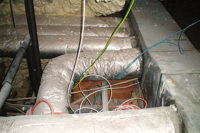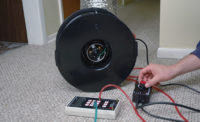
The purist will note that a furnace may expect to lose a percentage point or so in efficiency when the ducts are improved by 20% (this is because the furnace will cycle more often under the reduced heating load) but any such effect will be “lost in the noise.”
Far more important with this most common type of system is that insulating ducts and repairing leaks makes it possible to downsize the equipment.
Whether selecting the equipment in new construction or deciding to do duct repair when equipment needs replacing, the ability to use a smaller heating-cooling plant saves on the up-front cost (particularly in cooling), and in new construction, it allows the ducts themselves to be downsized.
This results in an excellent and exemplary design process, “a virtuous circle” rather than a vicious one, with one improvement leading to the possibility of another.
(Note: This discussion refers to the efficiency of the equipment, not the ducts. The benefits described in this section are in addition to benefits from reduced duct losses.)
Heat pumps present a special case. The most common type of air-source heat pump employs electric resistance backup heaters, which come into play as a falling temperature increases the heating load and decreases the ability of the compressor to meet that load. These resistance coils are much less efficient than the heat pump itself. Therefore, any change to the rest of the system that reduces the heat pump’s dependence on resistance backup is sure to improve the overall efficiency of the machine.
Sealing and insulating ducts reduces the load the heat pump must meet at any given outdoor temperature. As a result, the compressor can handle the load at lower outdoor temperatures
than before. This can result in a system efficiency improvement 50% greater than one would expect considering the ducts by themselves.
Insulating supply ducts also raises the delivered air temperature in the heating mode, a significant comfort benefit in heat pump systems because of the reduced perception of draftiness.
Like heat pumps, variable-capacity furnaces and air conditioners have two operating modes; the low-capacity mode is usually more efficient than its higher-capacity counterpart. For the same reasons as those discussed above, improvements in duct efficiency give added benefits in average equipment efficiency.
Geothermal heat pumps are rapidly increasing in popularity. Key to their success is minimizing the cost of the in-ground heat exchanger. It’s counterproductive to incur the cost of extra boreholes to feed duct losses. An optimized geothermal heat pump system almost always has its ducts in the conditioned space.
AIR INFILTRATION IMPACT
Operation of the air handler fan often changes the distribution of air pressures within the house. These effects are quite small when compared with the total pressure of the atmosphere, or even when compared with the much smaller pressure changes associated with changes in the weather. Nevertheless, they may significantly increase the amount of unconditioned air drawn into the house (air infiltration).Operation of the system fan can change the air infiltration rate in two ways. The first occurs if the air leakage rate from the supply ducts to the outside is different from the leakage rate from the outside into the return ducts.
Suppose, for example, that the supply leakage rate is greater than the return leakage; the duct system as a whole loses a net amount of air to the outside. Since the ducts can’t keep on losing air very long, they make it up from the house itself, pulling a little more air into the return registers than they deliver at the supply registers.
This pulls a slight suction on the house, which in turn causes more outside air to infiltrate through cracks in the envelope than would otherwise be the case. In the reverse case, where the return ducts leak more than the supply ducts, the system fan actually raises the pressure in the house; this in turn will cause the infiltration rate to drop. Usually this reduced infiltration is more than offset by the fact that the ducts are sucking in a net amount of outside air that must be heated or cooled.
System fan operation can also affect pressures in particular zones of the house, especially if there is only one return register and this register can be isolated from some of the rooms by closing doors. A typical case is where the return register is in a central hallway. When bedroom doors are closed, supply ducts cause the pressure in these bedrooms to rise, forcing conditioned air out of the house. At the same time, the zone containing the return register is depressurized, which increases the infiltration of outside air into this area. This effect tends to make duct systems less efficient.
Zone pressurization is important. Besides increasing energy use, it can affect health, safety, and comfort in several ways.
HEALTH HAZARDS, THERMAL COMFORT
Leakage in the duct system can be hazardous to your customers’ health. Especially problematic are leaky returns in an enclosed space such as a basement or garage that also contains the furnace. This is the situation shown in Figure 1.If the return ducts leak, their low pressure can pull down the pressure in the basement or garage as well, and this can suck flue gases from the furnace and radon gas from the soil surrounding the home. Flue gases can be hazardous to health if they contain carbon monoxide (CO). Exposure to radon gas from the ground is the second leading cause of lung cancer after smoking. Although experts disagree about how common these hazards are, by upgrading the energy efficiency of the duct system, you have an opportunity to avoid these potential problems.
Inefficient ducts also give rise to thermal comfort problems. One problem seen fairly often in southern climates is insufficient cooling capacity on the hottest days of the year. The first reaction is usually to blame the air conditioner, but often the problem is leaky or poorly insulated ducts that add so much to the cooling load that the air conditioner can’t handle it. Fix the ducts and the problem may go away. Other comfort problems sometimes caused by inefficient ducts include poor humidity control, poor conditioning of certain rooms, and too-low delivered air temperatures in heat pump systems.
Even if comfort isn’t directly affected, more subtle, long-term pressurization or depressurization conditions can cause degradation of the building envelope. In cold climates during winter, pressurization of the interior can drive moist air into exterior walls, where condensation of moisture can lead to mold growth and deterioration of wood and other materials within the wall cavity. In hot, humid climates, depressurization may cause problems. In this case the moisture is outside; when it is sucked into the wall, similar problems arise.
Sidebar: Dog Sniffs Out Microbial Damage
SAN FRANCISCO, CA — When authorities could find no evidence of microbial growth in an apartment complex in the German province of Nordrhein-Westfalen, they turned to an expert: Oskar, the “mold dog.”“The use of rescue dogs after earthquakes…and the use of tracker dogs to find hidden drugs or explosives is well known,” said Thomas Diederich, Dipl.-Ing. “Swedish dog-leaders were the first to develop the idea of using dogs to find hidden microbial damage.”
Diederich presented a paper on “How to Find Hidden Microbial Growth With a Mold Dog,” at the IAQ 2001 conference, “Moisture, Microbes and Health Effects: Indoor Air Quality and Moisture in Buildings,” held here in San Francisco and sponsored by ASHRAE.
Shortly after several families moved into the apartment complex, health complaints surfaced. “Investigation showed that mold was present,” Diederich said. “But only a small amount was found in a few apartments, such as near bathroom windows and behind a cupboard.”
Oskar was brought in and indicated the presence of mold on the wall. His discovery was confirmed by further testing.
Diederich said mold dogs can effectively examine commercial structures, such as office buildings. A search of an office building with 200 rooms took one dog 8 hrs. “To use only measurements of moisture would have lasted several days, probably without any result,” he said.
Publication date: 01/28/2002





